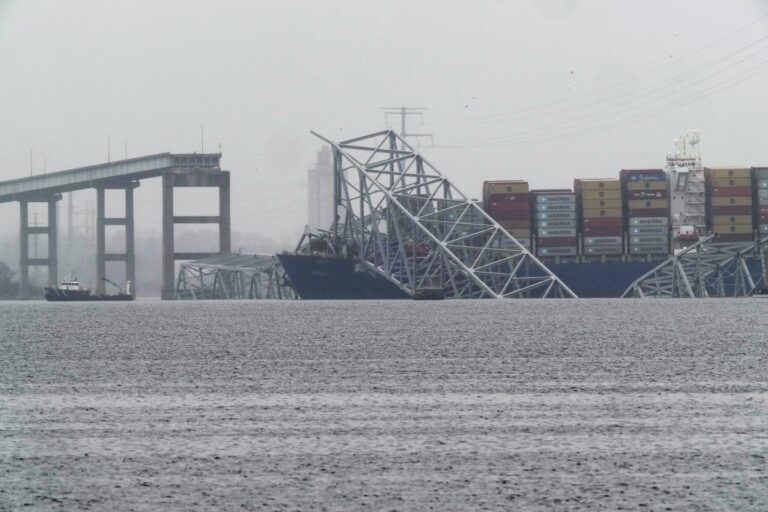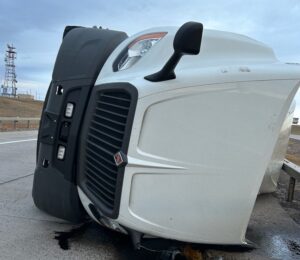WASHINGTON — After a massive barge struck and collapsed Baltimore’s Francis Scott Key Bridge on March 26, many in the nation, especially those who work in the transportation and logistics industry, began wondering about the safety of other U.S. bridges.
The answer, according to a study by national transportation research nonprofit TRIP, is that at least 3% of the nation’s Interstate Highway System Bridges are rated as being in poor condition.
A total of 59% are rated in fair condition.
Bridges in poor condition have significant deterioration of the bridge deck, supports or other major components.
A fair rating indicates that a bridge’s structural elements are sound but minor deterioration has occurred to the bridge’s deck, substructure or superstructure.
During its latest federal inspection, the Key Bridge, which carried Interstate 65 across the Patapsco River, scored a six out of nine, which is considered “fair.”
“In addition to the need to evaluate bridges to ensure adequate safety measures are in place to safeguard their sustainability despite increasing ship sizes and weights, increased vehicle travel on the bridge and changing environmental conditions, the collapse of the Francis Scott Key Bridge also spotlights the importance of the Interstate Highway System in supporting the nation’s supply chain and the continued growth in freight movement in the U.S.,” according to a TRIP news release.
According to a 2023 TRIP report, in 2022 the U.S. freight system moved 19.7 billion tons of freight, valued at $18.8 trillion, with trucks carrying 72% of freight by value and 64% by weight. From 2000 to 2022, vehicle miles of travel by large commercial trucks in the U.S. increased by 44%.
From 2022 to 2050, freight moved annually in the U.S. by trucks is expected to increase 93% in value (inflation-adjusted dollars) and 47% by weight.
U.S. business logistics costs reached $2.3 trillion in 2022, representing 9.1% of U.S. GDP — the highest share ever.
“The tragic collapse of the Key Bridge in Baltimore has had a significant impact on businesses across Maryland, disrupting the movement of goods and people throughout the region,” said Mary D. Kane, president and CEO of the Maryland Chamber of Commerce. “This event has underscored the crucial role that our nation’s infrastructure plays in supporting the daily lives of our citizens and the smooth functioning of our economy. As the unified voice of the Maryland business community, we are committed to continuing to work with our Building Bridges to Recovery Coalition, state and federal partners, as well as businesses across the state to advocate for the resources and policies needed to address these infrastructure challenges and preserve the resilience of our supply chains.”
A 2019 Transportation Research Board (TRB) report found that the U.S. Interstate Highway System has a persistent and growing backlog of physical and operational deficiencies as a result of age, heavy use and deferred reinvestment, and is in need of major reconstruction and modernization. The TRB report concludes that annual investment in the Interstate Highway System should be increased approximately two-and-a-half times, from $23 billion in 2018 to $57 billion annually over the next 20 years. In 2022, 13% of travel on Interstate highways and 22% of travel on rural Interstate highways was by combination trucks and 57% of large commercial truck vehicle miles of travel in 2022 was on Interstate highways.
While the amount and value of goods being shipped have risen to unprecedented levels, mounting traffic congestion is increasing the cost of moving freight and reducing the economic competitiveness and efficiency of businesses that require reliable, affordable freight transportation. Traffic congestion results in $95 billion annually in the cost of commercial trucks being stuck in traffic for 1.3 billion hours.
“The interruption in the flow of freight and travel both on Baltimore’s Key Bridge and in the channel below highlights the importance of our nation’s transportation network in safely and reliably moving goods and people,” said David Kearby, executive director of TRIP. “A transportation system that is well-maintained, safe, efficient and adequately funded is critical to our nation’s economy and the quality of life and safety of those who rely on it.”
The chart below provides state-by-state data for freight movement by value and weight, the projected increase in freight movement by value and weight from 2022-2050, the share of vehicle miles of travel (VMT) by combination trucks on the Interstate and on Rural Interstates, and the share of Interstate bridges in poor and fair condition.

Born in Pine Bluff, Arkansas, and raised in East Texas, John Worthen returned to his home state to attend college in 1998 and decided to make his life in The Natural State. Worthen is a 20-year veteran of the journalism industry and has covered just about every topic there is. He has a passion for writing and telling stories. He has worked as a beat reporter and bureau chief for a statewide newspaper and as managing editor of a regional newspaper in Arkansas. Additionally, Worthen has been a prolific freelance journalist for two decades, and has been published in several travel magazines and on travel websites.














